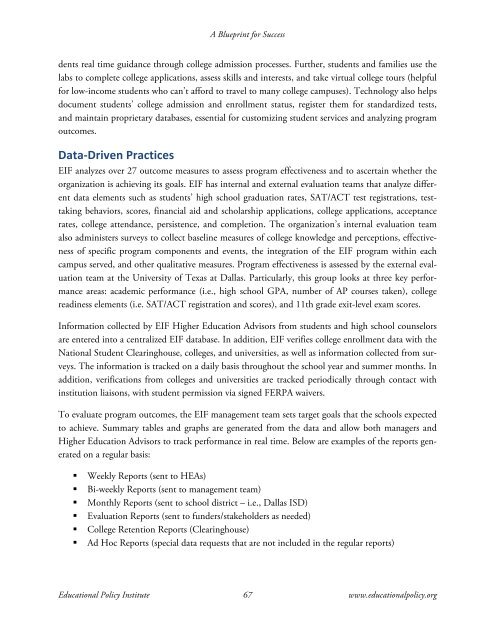A BluePrint for Success: Case Studies of Successful - Educational ...
A BluePrint for Success: Case Studies of Successful - Educational ...
A BluePrint for Success: Case Studies of Successful - Educational ...
You also want an ePaper? Increase the reach of your titles
YUMPU automatically turns print PDFs into web optimized ePapers that Google loves.
A Blueprint <strong>for</strong> <strong>Success</strong><br />
dents real time guidance through college admission processes. Further, students and families use the<br />
labs to complete college applications, assess skills and interests, and take virtual college tours (helpful<br />
<strong>for</strong> low-income students who can’t af<strong>for</strong>d to travel to many college campuses). Technology also helps<br />
document students’ college admission and enrollment status, register them <strong>for</strong> standardized tests,<br />
and maintain proprietary databases, essential <strong>for</strong> customizing student services and analyzing program<br />
outcomes.<br />
Data-‐Driven Practices<br />
EIF analyzes over 27 outcome measures to assess program effectiveness and to ascertain whether the<br />
organization is achieving its goals. EIF has internal and external evaluation teams that analyze different<br />
data elements such as students’ high school graduation rates, SAT/ACT test registrations, testtaking<br />
behaviors, scores, financial aid and scholarship applications, college applications, acceptance<br />
rates, college attendance, persistence, and completion. The organization’s internal evaluation team<br />
also administers surveys to collect baseline measures <strong>of</strong> college knowledge and perceptions, effectiveness<br />
<strong>of</strong> specific program components and events, the integration <strong>of</strong> the EIF program within each<br />
campus served, and other qualitative measures. Program effectiveness is assessed by the external evaluation<br />
team at the University <strong>of</strong> Texas at Dallas. Particularly, this group looks at three key per<strong>for</strong>mance<br />
areas: academic per<strong>for</strong>mance (i.e., high school GPA, number <strong>of</strong> AP courses taken), college<br />
readiness elements (i.e. SAT/ACT registration and scores), and 11th grade exit-level exam scores.<br />
In<strong>for</strong>mation collected by EIF Higher Education Advisors from students and high school counselors<br />
are entered into a centralized EIF database. In addition, EIF verifies college enrollment data with the<br />
National Student Clearinghouse, colleges, and universities, as well as in<strong>for</strong>mation collected from surveys.<br />
The in<strong>for</strong>mation is tracked on a daily basis throughout the school year and summer months. In<br />
addition, verifications from colleges and universities are tracked periodically through contact with<br />
institution liaisons, with student permission via signed FERPA waivers.<br />
To evaluate program outcomes, the EIF management team sets target goals that the schools expected<br />
to achieve. Summary tables and graphs are generated from the data and allow both managers and<br />
Higher Education Advisors to track per<strong>for</strong>mance in real time. Below are examples <strong>of</strong> the reports generated<br />
on a regular basis:<br />
Weekly Reports (sent to HEAs)<br />
Bi-weekly Reports (sent to management team)<br />
Monthly Reports (sent to school district – i.e., Dallas ISD)<br />
Evaluation Reports (sent to funders/stakeholders as needed)<br />
College Retention Reports (Clearinghouse)<br />
Ad Hoc Reports (special data requests that are not included in the regular reports)<br />
<strong>Educational</strong> Policy Institute 67 www.educationalpolicy.org




